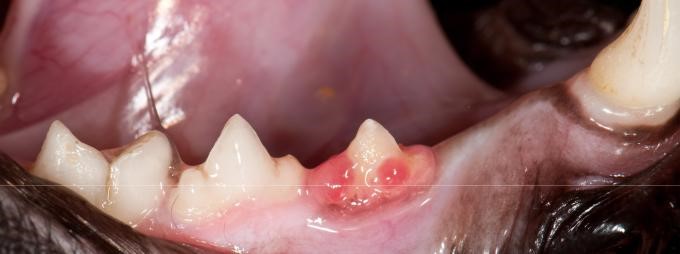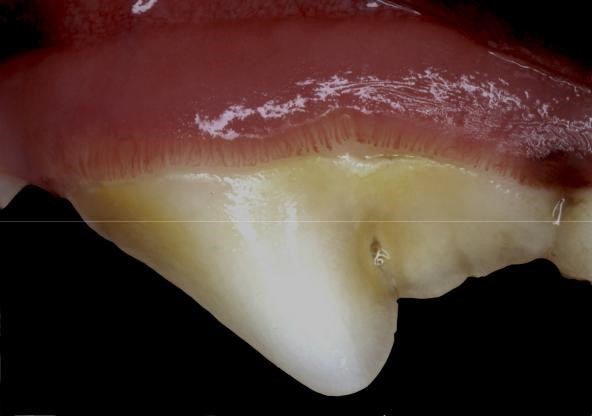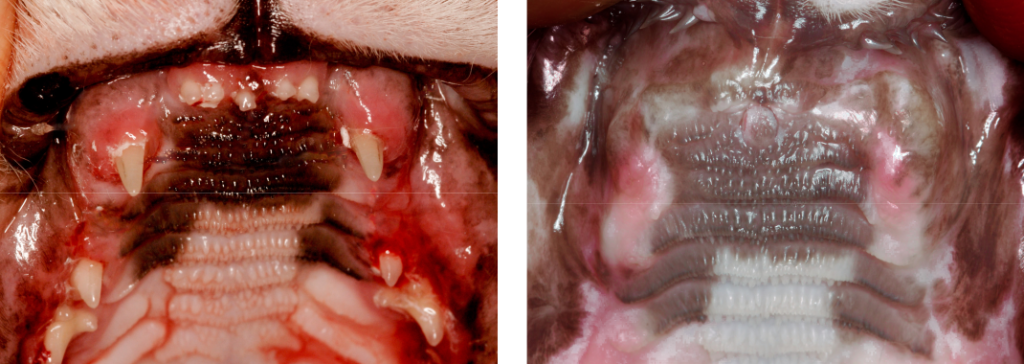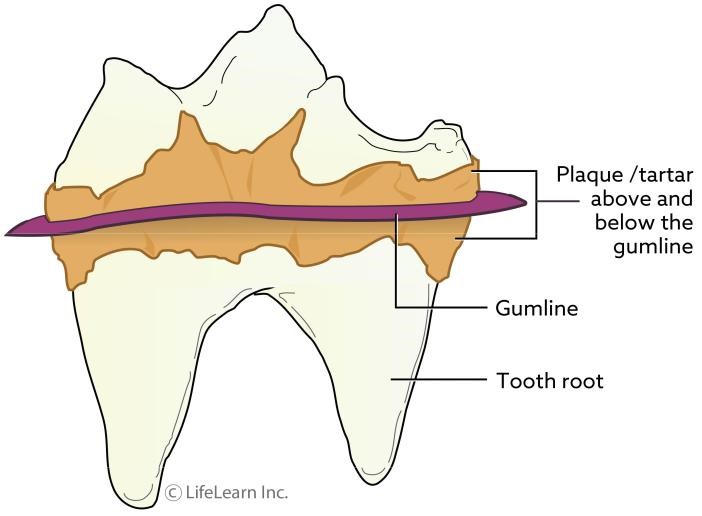How common is dental disease?
Dental disease is one of the most common medical conditions seen by veterinarians. Over 80% of dogs and more than half of all cats over the age of three have some degree of dental disease. The most common problems are due to gingivitis or inflammation of the gums, the accumulation of plaque, periodontal disease, and, in cats, tooth resorption (formerly called feline odontoclastic resorptive lesions, or cervical neck lesions).

Are dental problems the same in pets and people?
No. In people, the most common problem is tooth decay which is due to the loss of calcium from the tooth’s enamel, resulting in painful, infected cavities (caries). In dogs, tooth decay is rare representing less than 10% of all dental problems. The most common dental problems seen in dogs are periodontal disease and fractured teeth, while cats will often present with gingivostomatitis and periodontal disease.
What are the clinical signs of dental disease?
Few dogs and cats display signs of dental disease even though they are in pain, their pain threshold is estimated to be 8 times that of a normal human being. Pain may be shown by pawing at the mouth or head shaking. They may chew with obvious discomfort, drop food from their mouth, swallow with difficulty, or drool excessively – their saliva may contain blood. Halitosis, or an unpleasant breath odour, is also common.
What causes dental disease?
The most common cause of dental disease in pets is tartar and calculus accumulation on the teeth. The tooth surfaces are home to thousands of bacteria that multiply and produce a layer of plaque. Some of this plaque is naturally removed during eating or by the action of the pet’s tongue. However, the remaining plaque quickly mineralizes, forming tartar and calculus. Gingivitis and periodontal disease are caused by the body’s immune response to plaque accumulation.
The accumulation of tartar and bacteria on the tooth surfaces leads to infection and inflammation of the gums, also known as gingivitis. If the disease is caught at an early stage and a thorough veterinary dental scaling and polishing is performed, most of the teeth and gums will have a full recovery. However, if gingivitis is allowed to persist untreated, then irreversible periodontal disease will occur.
The cause of tooth resorption in cats is currently unknown, some theories suggest that vitamin D deficiency or progression of periodontal disease is responsible, however there is currently no consensus among the veterinary community.
What is periodontal disease?
Periodontal disease is a term used to describe inflammation or infection of the tissues surrounding the tooth. Periodontal diseases occur when the accumulation of plaque and tartar cause either periodontal pockets or gum recession around the tooth’s attachment. Left untreated, the infection often spreads deeper into the tooth socket, causing osteomyelitis or onfection of the bone. Ultimately, the tooth becomes loose and may fall out over time.
The bacteria can also spread through the bloodstream and lead to infectious endocarditis, a bacterial infection most commonly affecting the valves within the heart.
Once periodontal disease starts the degenerative changes to the tooth and its support structures, the changes cannot be reversed. These changes make it easier for more plaque and tartar to collect, resulting in further disease.
It is estimated that more than two-thirds of dogs over three years of age suffer from some degree of periodontal disease, making it by far the most common disease affecting pet dogs.

Is gingivitis always associated with dental disease?
It may be normal for some kittens and adult cats without evidence of dental disease to have a slight degree of redness appear as a thin line along the edge of the gum.
Some cats, however, develop severe oral inflammation called stomatitis – they actually become allergic to the plaque on their teeth. The cause of this condition is poorly understood, but it is likely caused by several factors and may differ in individual cases. Viruses such as Calici, Feline Immunodeficiency, Feline Leukaemia and Herpes Virus should be ruled out, other considerations are hypersensitivities and some bacteria which dramatically worsen clinical symptoms.
The only treatment that has produced consistent results is extraction of either all of the teeth or, in some cases, only those teeth behind the canines to decrease the plaque-retentive surfaces (surfaces that tend to hold on to plaque). With extraction, 60% of affected cats are cured, 20% require additional care to control the disease, and 20% are not cured.

What is tooth resorption?
Tooth resorption (formerly known as cervical neck lesions or feline odontoclastic resorptive lesions) is a progressive destruction of the tooth root resulting in slowly deepening “holes” in the affected teeth. Once sensitive parts of the tooth are exposed, these lesions become intensely painful and the only effective and humane treatment is to extract the tooth. While the cause of this disease is unknown, poor oral hygiene can play a role in the disease process.

What is involved with a routine dental cleaning?
A routine dental cleaning involves a thorough dental examination, followed by a dental scaling and polishing to remove the plaque and tartar from all tooth surfaces. Your veterinarian will perform pre-anesthetic blood tests to ensure that kidney and liver function are satisfactory for anesthesia. Sometimes antibiotic treatment is started before the periodontal therapy is performed. Your veterinarian will discuss the specific pre-dental recommendations for your pet.
Once your dog is anesthetized, your veterinarian will thoroughly examine the mouth, noting the alignment of the teeth and the
extent of tartar accumulation both above and below the gumline. Your veterinarian may also wish to perform dental radiographs to assess the viability of the tooth root and surrounding bone. If periodontal disease is severe, it may not be possible to save badly affected teeth, which may need to be extracted. Next, tooth scaling will be performed using both traditional hand scalers and ultrasonic cleaning equipment to remove all traces of tartar, both above and below the gum line. The tartar below the gum line causes the most significant gum recession and it is extremely important that it is removed thoroughly. After scaling, the teeth are polished to remove microscopic scratches in order to help prevent subsequent plaque build-up.
If your furbaby shows any symptoms of periodontal disease please make an appointment and look out for our annual dental promotions.
Victory is always here to inform and assist you in caring for your furbaby!






